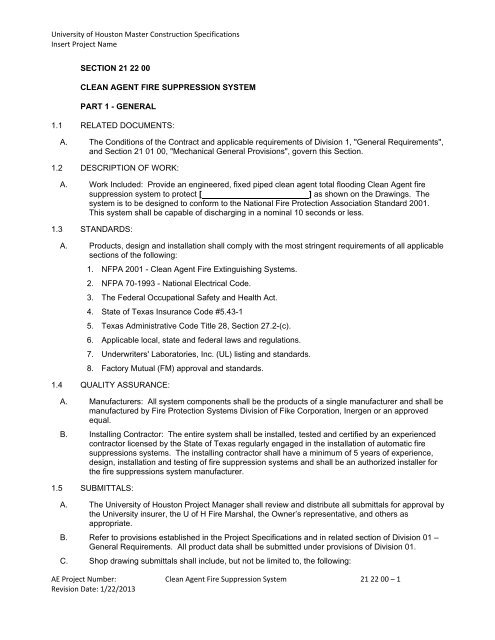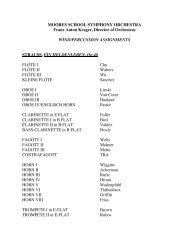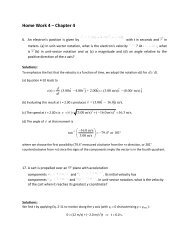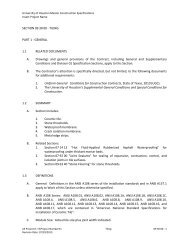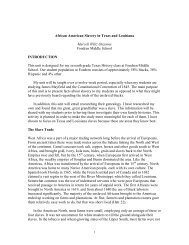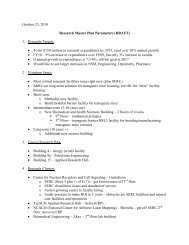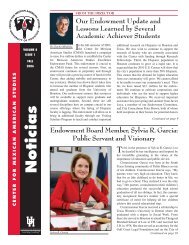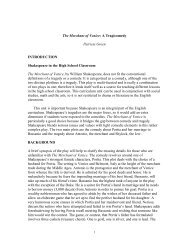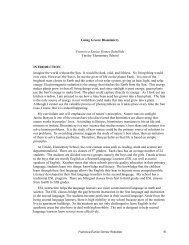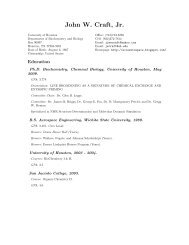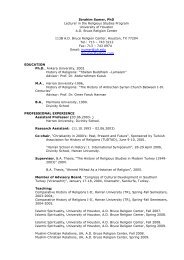21 22 00 Clean Agent Fire Suppression System - University of ...
21 22 00 Clean Agent Fire Suppression System - University of ...
21 22 00 Clean Agent Fire Suppression System - University of ...
You also want an ePaper? Increase the reach of your titles
YUMPU automatically turns print PDFs into web optimized ePapers that Google loves.
<strong>University</strong> <strong>of</strong> Houston Master Construction Specifications<br />
Insert Project Name<br />
SECTION <strong>21</strong> <strong>22</strong> <strong>00</strong><br />
CLEAN AGENT FIRE SUPPRESSION SYSTEM<br />
PART 1 - GENERAL<br />
1.1 RELATED DOCUMENTS:<br />
A. The Conditions <strong>of</strong> the Contract and applicable requirements <strong>of</strong> Division 1, "General Requirements",<br />
and Section <strong>21</strong> 01 <strong>00</strong>, "Mechanical General Provisions", govern this Section.<br />
1.2 DESCRIPTION OF WORK:<br />
A. Work Included: Provide an engineered, fixed piped clean agent total flooding <strong>Clean</strong> <strong>Agent</strong> fire<br />
suppression system to protect [ ] as shown on the Drawings. The<br />
system is to be designed to conform to the National <strong>Fire</strong> Protection Association Standard 2<strong>00</strong>1.<br />
This system shall be capable <strong>of</strong> discharging in a nominal 10 seconds or less.<br />
1.3 STANDARDS:<br />
A. Products, design and installation shall comply with the most stringent requirements <strong>of</strong> all applicable<br />
sections <strong>of</strong> the following:<br />
1. NFPA 2<strong>00</strong>1 - <strong>Clean</strong> <strong>Agent</strong> <strong>Fire</strong> Extinguishing <strong>System</strong>s.<br />
2. NFPA 70-1993 - National Electrical Code.<br />
3. The Federal Occupational Safety and Health Act.<br />
4. State <strong>of</strong> Texas Insurance Code #5.43-1<br />
5. Texas Administrative Code Title 28, Section 27.2-(c).<br />
6. Applicable local, state and federal laws and regulations.<br />
7. Underwriters' Laboratories, Inc. (UL) listing and standards.<br />
8. Factory Mutual (FM) approval and standards.<br />
1.4 QUALITY ASSURANCE:<br />
A. Manufacturers: All system components shall be the products <strong>of</strong> a single manufacturer and shall be<br />
manufactured by <strong>Fire</strong> Protection <strong>System</strong>s Division <strong>of</strong> Fike Corporation, Inergen or an approved<br />
equal.<br />
B. Installing Contractor: The entire system shall be installed, tested and certified by an experienced<br />
contractor licensed by the State <strong>of</strong> Texas regularly engaged in the installation <strong>of</strong> automatic fire<br />
suppressions systems. The installing contractor shall have a minimum <strong>of</strong> 5 years <strong>of</strong> experience,<br />
design, installation and testing <strong>of</strong> fire suppression systems and shall be an authorized installer for<br />
the fire suppressions system manufacturer.<br />
1.5 SUBMITTALS:<br />
A. The <strong>University</strong> <strong>of</strong> Houston Project Manager shall review and distribute all submittals for approval by<br />
the <strong>University</strong> insurer, the U <strong>of</strong> H <strong>Fire</strong> Marshal, the Owner’s representative, and others as<br />
appropriate.<br />
B. Refer to provisions established in the Project Specifications and in related section <strong>of</strong> Division 01 –<br />
General Requirements. All product data shall be submitted under provisions <strong>of</strong> Division 01.<br />
C. Shop drawing submittals shall include, but not be limited to, the following:<br />
AE Project Number: <strong>Clean</strong> <strong>Agent</strong> <strong>Fire</strong> <strong>Suppression</strong> <strong>System</strong> <strong>21</strong> <strong>22</strong> <strong>00</strong> – 1<br />
Revision Date: 1/<strong>22</strong>/2013
<strong>University</strong> <strong>of</strong> Houston Master Construction Specifications<br />
Insert Project Name<br />
1. Material and equipment information including manufacturers catalog cuts and technical data for<br />
each component or device used in the system which shall include, but not be limited to,<br />
detectors, manual discharge switches, abort switches, control panel, graphic annunciator, alarm<br />
devices, extinguishing agent and extinguishing agent storage containers, mounting brackets, and<br />
nozzles.<br />
2. Sequences <strong>of</strong> operation, electrical schematics and connection diagrams shall be provided to<br />
completely describe the operation <strong>of</strong> the <strong>Clean</strong> <strong>Agent</strong> fire suppression system controls.<br />
3. The Contractor shall illustrate the <strong>Clean</strong> <strong>Agent</strong> distribution system and provide calculations to<br />
demonstrate the volumetric concentration. The following information is to be provided for each:<br />
a. Room dimensions and volume.<br />
b. Design temperature.<br />
c. Specific volume and pressure at design.<br />
d. Any air change rate not shutdown (cfm).<br />
e. <strong>Clean</strong> <strong>Agent</strong> volume required.<br />
f. Discharge time.<br />
g. Number and size <strong>of</strong> nozzles.<br />
h. <strong>Agent</strong> discharged per discharge nozzle.<br />
i. Computerized hydraulic calculations <strong>of</strong> the agent distribution system taking into account<br />
each component <strong>of</strong> piping and the frictional losses associated with that component.<br />
j. Concentration <strong>of</strong> agent at design.<br />
4. Shop drawings submittals shall indicate locations, installation details and operation details <strong>of</strong> all<br />
equipment associated with the <strong>Clean</strong> <strong>Agent</strong> fire suppression system. Floor plans showing<br />
equipment locations, piping and other details, as required, shall be provided. Floor plans shall be<br />
drawn to a scale <strong>of</strong> not less than 1/4" = 1'-0". Elevations, cross sections and other details shall<br />
be drawn to a larger scale, as required.<br />
5. No work shall be performed until the <strong>University</strong> has approved the shop drawings, calculations,<br />
and data sheets. The Contractor is solely liable for any work performed prior to this approval.<br />
6. Information outlining warranty <strong>of</strong> each component or device used in the system.<br />
7. Elevation <strong>of</strong> the graphic annunciator panel including all nameplates, text, and control devices.<br />
8. Complete and detailed point-to-point wiring diagrams for all system components and devices.<br />
9. A copy <strong>of</strong> the form to be used for final system testing and certification.<br />
10. Additional information as required in Section 23 01 <strong>00</strong>.<br />
1.6 DELIVERY, STORAGE AND HANDLING:<br />
A. Deliver fire suppression system components in factory-fabricated water resistant packaging.<br />
B. Handle fire suppressions system components carefully to avoid damages to components,<br />
enclosures, and finish.<br />
C. Store fire suppression system components in a clean, dry space, and protect from weather.<br />
PART 2 - PRODUCTS<br />
2.1 GENERAL REQUIREMENTS:<br />
AE Project Number: <strong>Clean</strong> <strong>Agent</strong> <strong>Fire</strong> <strong>Suppression</strong> <strong>System</strong> <strong>21</strong> <strong>22</strong> <strong>00</strong> – 2<br />
Revision Date: 1/<strong>22</strong>/2013
<strong>University</strong> <strong>of</strong> Houston Master Construction Specifications<br />
Insert Project Name<br />
A. The system shall be a total flooding <strong>Clean</strong> <strong>Agent</strong> fire suppression system designed to provide a<br />
uniform concentration <strong>of</strong> <strong>Clean</strong> <strong>Agent</strong> for the areas shown on the Drawings. The minimum agent<br />
concentration shall be 1% greater than the concentration required in NFPA for the agent being<br />
used.<br />
B. The amount <strong>of</strong> <strong>Clean</strong> <strong>Agent</strong> to be provided shall be the amount required to obtain a uniform<br />
concentration 1% greater than the concentration required in NFPA for the agent being used., for 10<br />
minutes. The Contractor shall take into consideration such factors as non-closeable openings,<br />
"coast-down" time <strong>of</strong> fans, time required for dampers to close, requirements for any additional<br />
dampers, and any other feature <strong>of</strong> the facility that could affect concentration.<br />
C. The work to be performed by the Contractor under this Specification includes all labor, materials,<br />
equipment, tools, supervision, storage, and each and every item <strong>of</strong> expense necessary to design,<br />
supply and install complete <strong>Clean</strong> <strong>Agent</strong> fire detection and suppression systems.<br />
D. The Contractor shall comply with all local, state, and federal laws and regulations and UH <strong>Fire</strong><br />
Marshall and with the Federal Occupational Safety and Health Act. The Contractor shall obtain any<br />
permits required at no additional cost.<br />
E. All work under this Contract shall be done in a neat and workmanlike manner whether finally<br />
concealed or exposed.<br />
F. All material and equipment furnished and installed shall be new and free <strong>of</strong> defects, <strong>of</strong> recent<br />
manufacture and standard manufacturer's equipment.<br />
2.2 SYSTEM DESIGN:<br />
A. All system components shall be designed and selected by a State <strong>of</strong> Texas licensed fire protection<br />
contractor. All system components shall be listed and approved by UL and FM, both individually<br />
and as used on this project as a system designed in accordance with NFPA.<br />
2.3 SYSTEM OPERATION:<br />
A. The system shall be actuated by an [addressable device] [dual zone] [or] [verified detection]<br />
system with [analog] photoelectric smoke detectors. Automatic operation in each protected area(s)<br />
shall be as follows:<br />
1. Actuation <strong>of</strong> an initial detector [in either zone] shall:<br />
a. Audibly and visually indicate the respective device in alarm at the control unit.<br />
b. [Illuminate the detector indicating LED on the graphic annunciator (Data Center only).]<br />
c. Activate the pre-alarm audible and visual signals associated with the area in which the<br />
detector is an alarm.<br />
d. Close the air conditioning system dampers serving the area in alarm, as applicable.<br />
e. Shut down dedicated air conditioning equipment serving the area in alarm.<br />
f. [Activate the remote alarm/trouble chime in the adjacent <strong>of</strong>fice area (Data Center<br />
only).]<br />
g. Initiate an alarm condition to the building fire alarm system [floor zone on the floor where<br />
the alarm occurred].<br />
2. Action <strong>of</strong> a second detector in the same area [, but on the second detection zone] shall:<br />
a. Audibly and visually indicate the respective device in alarm at the control unit.<br />
b. [Illuminate the detector indicating LED on the graphic annunciator (Data Center only).]<br />
c. Activate the discharge alarm audible and visual signals associated with the area in which the<br />
detector is in alarm.<br />
AE Project Number:<br />
Revision Date: 1/<strong>22</strong>/2013<br />
<strong>Clean</strong> <strong>Agent</strong> <strong>Fire</strong> <strong>Suppression</strong> <strong>System</strong> <strong>21</strong> <strong>22</strong> <strong>00</strong> – 3
<strong>University</strong> <strong>of</strong> Houston Master Construction Specifications<br />
Insert Project Name<br />
d. Actuate a time delay mechanism which shall delay release <strong>of</strong> the <strong>Clean</strong> <strong>Agent</strong> for 30<br />
seconds. The <strong>Clean</strong> <strong>Agent</strong> shall be released at the end <strong>of</strong> this time interval unless a " <strong>Clean</strong><br />
<strong>Agent</strong> Hold" (Abort) button is pressed at any time during the interval which shall immediately<br />
restore the time delay mechanism. Upon release, the time delay cycle will restart unless the<br />
entire system has been restored to normal by pressing the reset button on the control unit.<br />
Time in seconds remaining to discharge shall be displayed at digital abort stations.<br />
3. Timing out <strong>of</strong> the time delay shall:<br />
a. Shut down power to all equipment within the <strong>Clean</strong> <strong>Agent</strong> protected area in alarm via a dry<br />
relay contact.<br />
b. Discharge <strong>Clean</strong> <strong>Agent</strong> in the zone in alarm in the total space.<br />
c. Activate the <strong>Clean</strong> <strong>Agent</strong> discharge strobes associated with the zone in alarm.<br />
B. The system shall be capable <strong>of</strong> being actuated by manual discharge switches in the projected area.<br />
Operation <strong>of</strong> a manual discharge switch shall cause immediate or optionally programmable delayed<br />
discharge <strong>of</strong> the <strong>Clean</strong> <strong>Agent</strong> and shall cause alarm and shutdown devices to operate the same as<br />
if the system had operated automatically. Operation <strong>of</strong> a manual discharge switch shall be provided<br />
in each projected area at the exits and as shown on the Drawings.<br />
C. <strong>System</strong> design shall incorporate the capability <strong>of</strong> checking all detection, discharge, abort power and<br />
air conditioning shut<strong>of</strong>f, damper control functions without discharge <strong>of</strong> the <strong>Clean</strong> <strong>Agent</strong>. It shall also<br />
be possible to test without shutting <strong>of</strong>f computer power and/or air conditioning equipment. The<br />
system shall include an emergency power backup. Upon loss <strong>of</strong> power supplying the control unit,<br />
the system shall automatically transfer to standby power supplied by the control unit, and stay on<br />
line for 24 hours <strong>of</strong> supervision with capacity for <strong>Clean</strong> <strong>Agent</strong> release and 5 minutes <strong>of</strong> system<br />
alarm.<br />
D. <strong>System</strong> supervision shall be provided to detect trouble conditions in all connected devices and<br />
wiring. A system trouble condition shall initiate the following:<br />
1. Indicate the respective zone/device in trouble condition at the control unit.<br />
2. [Activate the remote alarm/trouble chime in the adjacent <strong>of</strong>fice area (Data Center only).]<br />
3. Initial a trouble condition on the building fire alarm system [floor zone on the floor where the<br />
trouble condition].<br />
2.4 DEVICE LOCATIONS:<br />
A. <strong>System</strong> devices shall be located as follows:<br />
1. Control panel [and graphic annunciator] shall be located as shown on the Drawings. Panels<br />
shall be flush-mounted, unless noted otherwise on the Drawings.<br />
2. Smoke detectors shall be installed [above the ceiling,] on the ceiling [and below the raised<br />
access floor] <strong>of</strong> each protected area. Minimum number <strong>of</strong> detectors shall be as shown on the<br />
Drawings.<br />
3. Manual discharge stations shall be installed at each exit from protected areas and as shown on<br />
the Drawings.<br />
4. A digital abort station shall be installed next to the control panel and in the [<br />
.]<br />
5. Standard abort stations shall be provided at locations shown on the Drawings.<br />
6. Audible and visual alarm devices for pre-alarm and discharge alarm shall be located in the<br />
protected areas. A visual discharge signal shall be located outside each entrance to the<br />
protected area. [A remote combination trouble/alarm chime shall be provided in the <strong>of</strong>fice<br />
area adjacent to the protected area.]<br />
AE Project Number: <strong>Clean</strong> <strong>Agent</strong> <strong>Fire</strong> <strong>Suppression</strong> <strong>System</strong> <strong>21</strong> <strong>22</strong> <strong>00</strong> – 4<br />
Revision Date: 1/<strong>22</strong>/2013
<strong>University</strong> <strong>of</strong> Houston Master Construction Specifications<br />
Insert Project Name<br />
2.5 SYSTEM CONTROL PANEL:<br />
A. General: Provide an integrated system <strong>of</strong> automatic detection devices. The devices, along with<br />
manual stations shall be used to activate a control panel. This panel shall process all input signals,<br />
sequence the levels <strong>of</strong> alarm signals, and provide outputs to shutdown fans, activate dampers,<br />
contact other agencies, annunciate on remote devices as specified. The system shall have a<br />
standard standby battery supply to provide a minimum <strong>of</strong> 24 hours <strong>of</strong> emergency power. Detection<br />
wiring shall be <strong>of</strong> a Class "B" type and utilize devices connected in parallel.<br />
[SELECT ONE OF THE FOLLOWING]<br />
[ADDRESSABLE DEVICE]<br />
B. [Control Panel: The control panel for the Automatic <strong>Fire</strong> Detection and Alarm <strong>System</strong> and<br />
<strong>Clean</strong> <strong>Agent</strong> <strong>Fire</strong> <strong>Suppression</strong> <strong>System</strong> shall be a Fike Cheetah or approved equal fire control<br />
system. The control panel shall be UL and ULC-listed for <strong>Clean</strong> <strong>Agent</strong> discharge and bear<br />
Factory Mutual approval. The control panel shall include the following modules:<br />
1. Ideally suited for <strong>Fire</strong> Alarm, <strong>Clean</strong> <strong>Agent</strong> <strong>Suppression</strong>, Carbon Dioxide <strong>Suppression</strong>, and<br />
Sprinkle/Pre-Action fore Detection and Control <strong>System</strong>s<br />
2. Digital Communication Protocol with addressable devices and sensors to increase<br />
communications reliability and immunity to noise<br />
3. Response time <strong>of</strong> less than 3 seconds for fully loaded system<br />
4. Up to 240 zones to map initiation devices to control functions<br />
5. Two signaling Line Circuits (SLC) which support up to 254 addresssable points<br />
6. SLC distances <strong>of</strong> over 6<strong>00</strong>0’ possible<br />
7. SLC meets style 4, 6 or 7<br />
8. Input either 120Vac, 240Vac 50/60 Hz, or 24Vdc<br />
9. Power supply capable <strong>of</strong> supporting 508 points plus 5.0 A usable power plus 65 Ah <strong>of</strong><br />
standby battery capacity<br />
10. Two notification Appliance Circuits (NAC), 2.0A each<br />
11. Dedicated Alarm , Trouble and Supervisory SPDT relays(30 Vdc/2A, 110Vac/0.5A)<br />
12. Two continuous and one resetable auxiliary power outputs, 2.0A each<br />
13. Releasing function provides three input types; cross zone, counting zone and single<br />
detector, and 6 abort types.<br />
14. Reliable s<strong>of</strong>tware and firmware integration utilizing KeyWord code construction and<br />
Intelligent Output controls<br />
15. 80 Character LCD display with 8 status LEDS to provide instant visual information<br />
16. Completely field programmable, without requiring use <strong>of</strong> a personal computer<br />
17. Automatic Learn mode allows quicker, reliable system configuration<br />
18. Three levels <strong>of</strong> password protection with built in individual user pr<strong>of</strong>iles<br />
19. Full function 24 button keypad<br />
20. 18<strong>00</strong> event history buffer with dedicated 6<strong>00</strong> event alarm buffer<br />
<strong>21</strong>. Two levels <strong>of</strong> adjustable pre-alarm thresholds for smoke sensor to provide early warning<br />
indication <strong>of</strong> potential emergency conditions<br />
AE Project Number: <strong>Clean</strong> <strong>Agent</strong> <strong>Fire</strong> <strong>Suppression</strong> <strong>System</strong> <strong>21</strong> <strong>22</strong> <strong>00</strong> – 5<br />
Revision Date: 1/<strong>22</strong>/2013
<strong>University</strong> <strong>of</strong> Houston Master Construction Specifications<br />
Insert Project Name<br />
[OR]<br />
<strong>22</strong>. Automatic Day/Night smoke sensor sensitivity adjustments with Weekend and Holiday<br />
schedule adjustments<br />
23. Automatic sensitivity testing in accordance w/NFPA 72<br />
24. Sophisticated Drift Compensation routines used on addressable sensors to compensate<br />
for dust/dirt accumulation<br />
25. Walktest capability with optional notification appliance verification<br />
26. Small; Enclosure, <strong>21</strong>.125” X 14.625” X 4:, capable <strong>of</strong> flush mounting without additional<br />
equipment.<br />
[VERIFIED DETECTION]<br />
C. [Control Panel: The Control Panel for the Automatic <strong>Fire</strong> Detection and <strong>Clean</strong> <strong>Agent</strong><br />
<strong>Suppression</strong> <strong>System</strong> shall be a Fike <strong>Fire</strong> <strong>Suppression</strong> <strong>System</strong> SHP or approved equal<br />
releasing control. The Control Panel shall be UL and ULC-listed and bear Factory Mutual<br />
approval.<br />
1. The control panel shall include:<br />
a. Verified detection (cross-zoning will [not] be considered equal).<br />
b. Parallel wired agent release modules using electrical initiators.<br />
c. Class "B" wiring <strong>of</strong> the detection and <strong>Clean</strong> <strong>Agent</strong> release circuits.<br />
d. Minimum <strong>of</strong> 24 hours <strong>of</strong> battery standby power, housed in same cabinet.<br />
e. Three supervised audible circuits, each individually silenceable.<br />
f. Three sets <strong>of</strong> auxiliary contacts.<br />
2. The control panel shall operate on the "verified Detection concept". Cross-zoning will<br />
[not] be considered as equal. With the verified detection concept, any single activated<br />
detector will be processed by the control panel and be indicated as an "Alarm 1"<br />
condition. This shall cause the "Alarm 1" audible circuit and the red "Alarm 1" LED on the<br />
cover to activate. The activation <strong>of</strong> any second detector, regardless <strong>of</strong> its location, shall<br />
cause the system to enter the "Alarm 2" condition, activate the "Alarm 2" audible circuit,<br />
and start the programmed, solid state, time delay circuit. If no time delay is programmed,<br />
then the system shall immediately discharge upon activation <strong>of</strong> the second detector. Each<br />
audible circuit be capable <strong>of</strong> being individually silenced.<br />
3. The control panel shall utilize parallel wired initiators at the method <strong>of</strong> discharging the<br />
extinguishing agent. The electrical initiator at each container shall be connected to the<br />
<strong>Agent</strong> Release Module which shall be a solid state circuit which provides the firing<br />
voltage. When a discharge signal is generated at the control panel, all agent release<br />
modules shall operate instantly discharging the containers. All <strong>Agent</strong> Release Modules<br />
shall be wired in a Class "B" configuration. [Any system utilizing series initiators, series<br />
solenoids or mechanically operated valves shall not be acceptable.] All relays shall be<br />
rated 10 amps.<br />
4. The control panel shall house its own standby battery power. Batteries shall be sized to<br />
provide a minimum <strong>of</strong> 24 hours stand by power but in no case shall be less than 6-1/2 AH<br />
capacity. Batteries shall be supervised and provide a trouble signal upon low battery<br />
voltage or open cell.<br />
5. The control panel shall accommodate supervised abort switches.<br />
AE Project Number: <strong>Clean</strong> <strong>Agent</strong> <strong>Fire</strong> <strong>Suppression</strong> <strong>System</strong> <strong>21</strong> <strong>22</strong> <strong>00</strong> – 6<br />
Revision Date: 1/<strong>22</strong>/2013
<strong>University</strong> <strong>of</strong> Houston Master Construction Specifications<br />
Insert Project Name<br />
6. The control panel shall be furnished with a solid state, field-programmable time delay.<br />
The time delay shall be programmable with a maximum setting <strong>of</strong> 60 seconds.<br />
7. The control panel shall be constructed <strong>of</strong> 18 gauge steel finished with [the manufacturers<br />
standard pain finish]. [a custom color or selected by the Architect.] Only the audio/visual<br />
signals activated shall be visible with the cabinet door closed. Cabinet shall be sized so<br />
that the batteries may be located in the same enclosure. All terminal strips which may<br />
have more than 24 volts dc, such as power input and auxiliary relays shall have protective<br />
covers to prevent anyone from coming into accidental contact with a live terminal.<br />
Cabinet shall be capable <strong>of</strong> being flush-mounted without the need <strong>of</strong> any accessories. the<br />
control panel shall operate <strong>of</strong>f <strong>of</strong> 120 volt ac, 60 cycle power. Within the panel the ac<br />
inputs shall be protected by a circuit breaker in lieu <strong>of</strong> fuses.]<br />
2.6 [GRAPHIC ANNUNCIATOR:<br />
A. Provide a flush-mounted LED type graphic annunciator. the annunciator shall be provided<br />
complete with all required circuit boards and LEDs for each device, lamp test button, and<br />
shall have a graphic representation <strong>of</strong> the protected area floor plan with appropriate<br />
descriptive legends silk screened on the annunciator face.]<br />
[SELECT ONE OF THE FOLLOWING]<br />
[ADDRESSABLE DEVICE]<br />
2.7 [SMOKE SENSORS (DETECTORS):<br />
A. Smoke sensors shall be Fike No. 63-0<strong>21</strong> or an approved equal base-mounted analog<br />
photoelectric smoke sensors. All sensors shall be <strong>of</strong> the photoelectric type and each sensor<br />
shall be individually addressable. Each sensor shall measure the percentage <strong>of</strong> obscuration<br />
due to airborne particles and report an analog value based on the percentage <strong>of</strong> obscuration<br />
to the control panel. Alarm thresholds shall be established at the control panel. Smoke<br />
sensors which make the alarm/normal decision internally will not be acceptable.<br />
B. The Fike Analog Photoelectric Smoke Sensor shall been designed with a unique chamber,<br />
enabling the sensor to be sensitive to a wider range <strong>of</strong> hazards than traditional<br />
photoelectric sensors. In addition to the better response to different hazard types, the<br />
sensor shall provide a dual point calilbration. Important operating parameters are<br />
maintained within the sensor using non-volatile RAM, increasing reliability and reducing<br />
chances <strong>of</strong> false alarm. The interrupt driven digital protocol combines maximum<br />
communication reliability with fast response to emergency conditions.<br />
C. Sensors shall be EMI, RFI and ESD-protected].<br />
[OR]<br />
[VERIFIED DETECTION]<br />
2.8 [SMOKE DETECTORS (PHOTOELECTRIC):<br />
A. Smoke detectors shall be Fike No. 63-024 or an approved equal base mounted photoelectric<br />
smoke detectors. Detectors shall utilize solid state circuitry, a pulsed infrared LED light<br />
source and a silicon photo diode receiving element. In normal conditions, the photo diode<br />
shall not sense any light from the LED source. When smoke particles enter the sensing<br />
chamber, the light source shall be reflected to the sensing element. Comparator circuitry<br />
shall be provided to discriminate between a valid "smoke" source and an intermittant "nonsmoke"<br />
source. The entrance to the sensing chamber shall be surrounded by a fine<br />
AE Project Number: <strong>Clean</strong> <strong>Agent</strong> <strong>Fire</strong> <strong>Suppression</strong> <strong>System</strong> <strong>21</strong> <strong>22</strong> <strong>00</strong> – 7<br />
Revision Date: 1/<strong>22</strong>/2013
<strong>University</strong> <strong>of</strong> Houston Master Construction Specifications<br />
Insert Project Name<br />
stainless steel mesh to minimize entry <strong>of</strong> foreign material into the sensing chamber.<br />
Detectors shall be dewpro<strong>of</strong> and uninfluenced by high air velocities.<br />
B. Each detector shall utilize a standard base interchangeable, without modifications with<br />
ionization or thermal detectors. The detector head shall be equipped with a LED which<br />
blinks while the detector is in normal standby and lights steadily upon the detector sensing<br />
an alarm condition. The detector shall have the ability to power a remote annunciator which<br />
shall duplicate the alarm LED during an alarm condition.<br />
C. The detector head shall be removable from its base from cleaning, service or replacement.<br />
The detector shall be capable <strong>of</strong> having its calibration checked or adjusted in the field via a<br />
standard detector sensitivity monitor. The detector may have its sensitivity tested either in<br />
place as it is exposed to the environment or in a calibrated smoke chamber to give a reading<br />
<strong>of</strong> sensitivity which can be referenced against other like detectors under know conditions.<br />
Detector shall be Factory Mutual approved and UL-listed to UL Standard 268.<br />
[SELECT FOR ADDRESSABLE SYSTEM ONLY]<br />
2.9 [ADDRESSABLE CONTACT MONITORING MODULES:<br />
A. Modules shall be Fike No. 55-019 or approved equal addressable contact modules. Modules<br />
shall supervise any normally open contact configuration. This module shall provide an<br />
output signal (with one poll <strong>of</strong> the device) to the Control Unit which contains all the present<br />
status <strong>of</strong> the addressable device. The output signals shall distinguish between three circuit<br />
conditions; normal (open contact), short circuit (closed contact), and open circuit (field wire<br />
break). The device shall incorporate a monitoring LED which blinks with each activation <strong>of</strong><br />
the address location. A seven bit dip switch shall be provided for individually assigning<br />
address locations to each device.]<br />
2.10 HORN/STROBE UNITS:<br />
A. Horn/Strobe assemblies shall be Fike No. PYU-MMT-S17 or an approved equal low power dc horn<br />
and high-intensity Xenon strobe visual signal. The strobe lens shall be white with "CLEAN AGENT"<br />
printed in red. Printing shall be oriented to suit the direction <strong>of</strong> installation. The horn shall be<br />
capable <strong>of</strong> dual-tone operation to indicate both pre-alarm and discharge alarm conditions.<br />
2.11 ALARM/TROUBLE CHIME:<br />
A. Alarm chimes shall be Fike or an approved equal low power, 24 volts dc alarm chime.<br />
2.12 DISCHARGE STROBES:<br />
A. Discharge strobes shall be Fike No. PYU-S17 or an approved equal high-intensity Xenon strobe<br />
visual signal. The strobe lens shall be white with " CLEAN AGENT " printed in red. Printing shall e<br />
oriented to suit the direction installation.<br />
2.13 MANUAL DISCHARGE STATIONS:<br />
A. Manual DISCHARGE stations shall be Fike No. MS.2H or equal red aluminum stations permanently<br />
labeled "FIRE" and " CLEAN AGENT DISCHARGE".<br />
2.14 ABORT STATIONS:<br />
A. Exit abort stations shall be Fike No. 10-1639 or approved equal momentary contact yellow<br />
pushbutton. Abort stations shall be permanently labeled " CLEAN AGENT DISCHARGE ABORT".<br />
2.15 DIGITAL ABORT STATIONS:<br />
AE Project Number: <strong>Clean</strong> <strong>Agent</strong> <strong>Fire</strong> <strong>Suppression</strong> <strong>System</strong> <strong>21</strong> <strong>22</strong> <strong>00</strong> – 8<br />
Revision Date: 1/<strong>22</strong>/2013
<strong>University</strong> <strong>of</strong> Houston Master Construction Specifications<br />
Insert Project Name<br />
A. Digital abort stations shall be Fike No. 20-040 or an approved equal combination momentary<br />
contact yellow pushbutton and digital readout indicating the number <strong>of</strong> seconds remaining until<br />
<strong>Clean</strong> <strong>Agent</strong> discharge. Abort stations shall be permanently labeled " CLEAN AGENT DISCHARGE<br />
ABORT".<br />
2.16 CLEAN AGENT<br />
A. General: The fire suppression agent shall be a clean, dry, non-corrosive, non-damaging, nondeteriorating<br />
gas meeting the requirements <strong>of</strong> NFPA. The agent shall be suitable for use in<br />
normally occupied spaces.<br />
B. Storage: The agent shall be stored in a container super pressurized with nitrogen to a maximum<br />
working pressure <strong>of</strong> 360 psia. Higher pressure agents are not acceptable.<br />
C. Characteristics: The agent shall be listed as acceptable on the EPA’s SNAP List. The agent shall<br />
also have the following characteristics:<br />
1. Ozone Depletion Potential <strong>of</strong> Zero (0).<br />
2. Atmospheric Lifetime <strong>of</strong> less than 50 years.<br />
3. LC50 > 8<strong>00</strong>,<strong>00</strong>0 ppm<br />
2.17 CLEAN AGENT STORAGE CONTAINERS:<br />
A. General: A common bank <strong>of</strong> properly sized Fike or an approved equal modular design <strong>Clean</strong> <strong>Agent</strong><br />
containers sized to the largest single hazard containing sufficient agent to produce the required<br />
concentration <strong>of</strong> <strong>Clean</strong> <strong>Agent</strong> shall be supplied. The containers shall have the capability <strong>of</strong> being<br />
charged to various weights, in one pound increments, so that excessive agent supply is avoided.<br />
B. Nameplate: Each container shall have a permanent nameplate indicating the manufacturer’s name<br />
and part number, agent fill weight and total charged weight.<br />
C. Charging Pressure: Container charging pressure shall be a maximum <strong>of</strong> 360 psig.<br />
D. Pressure Gauges: Each container shall be equipped with a pressure gauge to visually display<br />
internal pressure. Each gauge shall be color coded for fast reference <strong>of</strong> pressure readings.<br />
Pressure gauges shall be supplied as an integral part <strong>of</strong> each container.<br />
E. Discharge Releasing Valve: The discharge valves shall be a straight through, vertical discharge<br />
type with no direction changes to provide maximum discharge efficiency and safety. The discharge<br />
releasing valve shall consist <strong>of</strong> a fast acting, scored, non-fragmenting rupture membrane which will<br />
burst when the pyrotechnic initiator is activated via an electris signal from the fire suppression panel.<br />
Solenoid actuated releasing mechanisms are not acceptable.<br />
F. Actuator: Release <strong>of</strong> the agent shall be accomplished via Fike Model 10-1832 <strong>of</strong> an approved equal<br />
electrically activated pyrotechnic release initiators. <strong>System</strong>s using multiple storage containers shall<br />
have all initiators wired in parallel.<br />
G. Discharge Time: The containers and discharge valve shall be capable <strong>of</strong> releasing the agent as<br />
quickly as possible and full discharge time shall not exceed ten (10) seconds.<br />
H. Low Pressure Switch: Each agent storage container shall be equipped with a low pressure switch<br />
to indicate a loss <strong>of</strong> container pressure. A decrease in pressure from 360 psig to 275 psig shall<br />
cause a normally closed contact in the pressure switch to open, indicating a trouble condition at the<br />
fire suppression panel.<br />
I. Liquid Level Indicators: Each agent storage container with 1<strong>00</strong> pounds or more <strong>of</strong> agent shall be<br />
equipped with a Fike Model 10-xxx or an approved equal liquid level indicator to accurately indicate<br />
the amount <strong>of</strong> agent in the container.<br />
AE Project Number: <strong>Clean</strong> <strong>Agent</strong> <strong>Fire</strong> <strong>Suppression</strong> <strong>System</strong> <strong>21</strong> <strong>22</strong> <strong>00</strong> – 9<br />
Revision Date: 1/<strong>22</strong>/2013
<strong>University</strong> <strong>of</strong> Houston Master Construction Specifications<br />
Insert Project Name<br />
J. [Check Valves: All systems connected with a reserve supply shall be piped with check<br />
valves. Check valves shall be constructed <strong>of</strong> steel and shall be designed for a 750 psig<br />
working pressure.]<br />
K. Accessories: The containers are to stand in a normal upright position with suitable racking<br />
equipment, including an integral weigh-bar, low pressure switch, and liquid level indicator. All<br />
containers are to be <strong>of</strong> the same size and connected together by means <strong>of</strong> a common manifold<br />
sized to ensure the design discharge rate.<br />
2.18 CLEAN AGENT NOZZLES<br />
A. Nozzles: Provide <strong>Clean</strong> <strong>Agent</strong> nozzles in proper sizes and quantities to distribute evenly the <strong>Clean</strong><br />
<strong>Agent</strong> discharge. Each nozzle shall be capable <strong>of</strong> either 180 or 360 degree direction <strong>of</strong> coverage<br />
parallel to the floor and ceiling.. Nozzles shall be Fike 80 Series or an approved equal and shall be<br />
available in 1”, 1-1/2”, and 2” NPT sizes. Nozzles shall include provisions for mounting deflector<br />
plates. All nozzles shall be made <strong>of</strong> aluminum.<br />
B. Deflector Plates: Ceiling deflector plates shall be provided at all ceiling nozzles to allow discharge<br />
without damage to ceiling tiles and to eliminate the need to clip lay-in ceiling tiles to the grid.<br />
Deflector plates shall be constructed or corrosion resistant stainless steel and shall be Fike Model<br />
80-xxx or an approved equal. Deflector Plates shall be compatible with the nozzle which the are<br />
installed with.<br />
2.19 PIPE AND FITTINGS:<br />
A. General: Provide a suitable piping system to convey the <strong>Clean</strong> <strong>Agent</strong> from the cylinder battery to<br />
nozzles in the protected area.<br />
B. Materials: All pipe and fittings are to be hot-dipped galvanized and scale-free steel. The following<br />
specifications shall apply for a 360 psi system:<br />
1. Pipe: Galvanized, Schedule 40 screwed steel pipe, ASTM 53.<br />
2. Fittings: Galvanized, screwed malleable iron, 620 psi minimum working pressure, ASTM 197.<br />
2.20 SYSTEM WIRING:<br />
A. The equipment supplier shall furnish to the installing contractor a complete detailed point-to-point<br />
wiring diagram showing the system equipment and required number, type and sizes <strong>of</strong> conductors<br />
and conduit sizes. Where common devices which break the alarm circuit are installed on a common<br />
zone with shorting type device, the circuit breaking devices shall be wired electrically downstream <strong>of</strong><br />
the shorting type devices.<br />
B. All alarm system wiring shall be installed in an approved raceway.<br />
C. All alarm wiring shall be multiconductor, UL-listed FLP for limited energy (3<strong>00</strong> volt) and fire alarm<br />
applications, and NEC approved fire alarm cable. Wiring shall be installed in accordance with NEC,<br />
local codes, Article <strong>21</strong>0 <strong>of</strong> NFPA Standard 72, and manufacturer's recommendations. All wiring<br />
shall be copper and installed in conduit sized in accordance with the National Electrical Codes.<br />
D. Alarm system wiring shall be color coded.<br />
E. All alarm system junction boxes including covers, shall be secured, painted red and marked in black<br />
lettering. The black lettering shall indicate the circuit number and function <strong>of</strong> each circuit contained<br />
within the box.<br />
F. Wire size shall be determined by calculated voltage drop and circuit loading. Minimum wire size<br />
shall be as follows:<br />
1. #18 AWG twisted and shielded for data and communications circuits.<br />
2. #18 AWG for non-data and communications initiating and low voltage auxiliary control circuits.<br />
AE Project Number: <strong>Clean</strong> <strong>Agent</strong> <strong>Fire</strong> <strong>Suppression</strong> <strong>System</strong> <strong>21</strong> <strong>22</strong> <strong>00</strong> – 10<br />
Revision Date: 1/<strong>22</strong>/2013
<strong>University</strong> <strong>of</strong> Houston Master Construction Specifications<br />
Insert Project Name<br />
3. #16 AWG twisted for alarm circuits.<br />
4. #12 AWG for all EPO and air conditioning interface control circuits.<br />
G. All wiring for intelligent/addressable circuits shall be <strong>of</strong> the twisted/shielded type to guard against<br />
outside RF interference and induced noise.<br />
PART 3 - EXECUTION<br />
3.1 INSPECTION:<br />
A. Installer shall examine the areas and conditions under which the fire suppression system is to be<br />
installed and notify the Contractor in writing <strong>of</strong> conditions detrimental to the proper and timely<br />
completion <strong>of</strong> the work. Do not proceed until unsatisfactory conditions have been corrected.<br />
B. Where the project requires releasing <strong>of</strong> a clean agent system, the room or area in which the<br />
suppression system is located shall utilize two separate smoke detectors or activation <strong>of</strong> a manual<br />
release station to activate the suppression system.<br />
3.2 ALARM SYSTEM INSTALLATION:<br />
A. General: Install system components and materials in accordance with manufacturer's instructions,<br />
roughing-in drawings and details. Install electrical work and use electrical products complying with<br />
the requirements <strong>of</strong> the applicable Division 26 sections <strong>of</strong> these Specifications. Mount manual<br />
stations and alarm devices at heights specified in Section 23 03 <strong>00</strong> and Section 26 05 01. Heights<br />
in raised floor areas shall be from the finished raised floor. Install alarm output devices on walls or<br />
as shown on the Drawings.<br />
B. Wiring: All wiring shall be in accordance with NFPA 2<strong>00</strong>1, the National Electrical Code, and local<br />
codes. All wiring sizes shall conform to recommendations <strong>of</strong> the equipment manufacturer, and as<br />
indicated on the engineered shop drawings.<br />
1. Install alarm system line voltage and low-voltage wiring in a suitable raceway. Conceal alarm<br />
system conduit except in mechanical rooms and areas where other conduit and piping are<br />
exposed. Fasten flexible conductors, which bridge cabinets and doors, neatly along hinge side<br />
and protect against abrasion. Tie and support the conductors neatly.<br />
2. All wiring shall be run in a supervised fashion (i.e. no branch wiring or dog-legged wiring) per<br />
NFPA requirements such that any wiring disarrangement will initiate the appropriate trouble<br />
signals via the main control panel per NFPA and UL requirements. Intelligent loops may be Ttapped/branch<br />
wired due to inherent dynamic supervision.<br />
3. Wiring splices shall be kept to a minimum with required splices to be made in designated<br />
terminal boxes or at field device junction boxes. Transposing or color code changes <strong>of</strong> wiring will<br />
not be permitted. End-<strong>of</strong>-line supervisory devices shall be installed with the last device on the<br />
respective circuit. Said device shall be appropriately marked designating it as the terminating<br />
device on the respective circuit.<br />
4. No ac wiring or any other wiring shall be run in the same conduit as alarm wiring.<br />
5. Number code and color code conductors appropriately and permanently for future identification<br />
and servicing <strong>of</strong> the system.<br />
C. Conduit/Raceway: All wire shall be installed in an approved conduit/raceway system. Maximum<br />
conduit "fill" shall not exceed 40% per NEC.<br />
1. Conduit and raceway system shall be 1/2installed as specified other Sections <strong>of</strong> the<br />
Specifications.<br />
2. Minimum conduit size shall be 1/2"- ¾”EMT. Install conduit per engineered shop drawings.<br />
AE Project Number: <strong>Clean</strong> <strong>Agent</strong> <strong>Fire</strong> <strong>Suppression</strong> <strong>System</strong> <strong>21</strong> <strong>22</strong> <strong>00</strong> – 11<br />
Revision Date: 1/<strong>22</strong>/2013
<strong>University</strong> <strong>of</strong> Houston Master Construction Specifications<br />
Insert Project Name<br />
D. Labeling: All system controls, indicators and other devices shall be labeled with names,<br />
designations and operating instructions as applicable. Labels shall be either engraved nameplates<br />
or covered printed labels and shall be approved by the Architect/Engineer.<br />
E. Checkout: Check wiring to ensure that wiring is in accordance with the system manufacturer's<br />
wiring diagrams and that the system is free <strong>of</strong> open circuits, short circuits, and grounds.<br />
3.3 PIPING INSTALLATION:<br />
A. General: Install all <strong>Clean</strong> <strong>Agent</strong> piping in accordance with NFPA 2<strong>00</strong>1 and other applicable Division<br />
15 sections. All <strong>Clean</strong> <strong>Agent</strong> discharge piping shall be concealed to the maximum extent possible.<br />
B. Testing: All <strong>Clean</strong> <strong>Agent</strong> piping in accordance with NFPA 1<strong>00</strong>2.<br />
3.4 COORDINATION:<br />
A. It shall be the responsibility <strong>of</strong> the installing contractor to coordinate all requirements surrounding<br />
installation <strong>of</strong> the fire suppression system with all trades. Adequate coordination shall be provided<br />
to ensure proper installation and interface to all peripheral items required to interact with the fire<br />
alarm to provide a complete and functional system.<br />
B. The installing contractor shall be fully responsible for coordinating all system and device messages<br />
and system operation with the [Owner's] [Tenant's] Representatives and Operating Personnel.<br />
3.5 SYSTEM CHECKOUT AND TEST:<br />
A. A <strong>System</strong> checkout and test shall be performed to demonstrate and confirm to the Engineer,<br />
[Owner's] [Tenant's] representative and the fire department, that the fire suppression system is<br />
1<strong>00</strong>% operational upon completion <strong>of</strong> the installation, and that it complies with all local code<br />
requirements and these specifications. It is intended that the <strong>System</strong> Checkout and Test be<br />
followed by a continuing program <strong>of</strong> inspection testing and maintenance. The Contractor shall<br />
provide to the [Owner] [Tenant] a Maintenance, Inspection and Quarterly testing Contract upon<br />
completion and system checkout.<br />
B. The system checkout and test shall be performed after the fire suppression system installation is<br />
completed and before project acceptance. The <strong>System</strong> Checkout and Test shall be performed by a<br />
minimum <strong>of</strong> two licensed fire suppression system technicians, one <strong>of</strong> which is licensed by the State<br />
<strong>of</strong> Texas, and acceptable to the Engineer and the authority having jurisdiction. Testing shall verify<br />
that the entire fire suppression system functions as intended. All circuits and devices shall be tested<br />
and the entire fire suppression system functions as intended. All circuits and devices shall be tested<br />
and the testing shall include all functions and features except that a <strong>Clean</strong> <strong>Agent</strong> discharge test<br />
shall not be performed.<br />
C. This Contractor shall coordinate the test schedule with all necessary parties and subcontractors<br />
required to be present for a complete and functional test.<br />
D. The <strong>System</strong> Checkout and Test which is a comprehensive 1<strong>00</strong>% inspection and test <strong>of</strong> all new fire<br />
alarm system equipment and shall include, but not be limited to the following:<br />
1. <strong>Fire</strong> Alarm Control Equipment:<br />
a. A visual and functional test <strong>of</strong> all fire alarm control and auxiliary control equipment.<br />
b. A visual inspection shall be conducted to establish that all electrical connections and<br />
equipment as required are properly installed and operating.<br />
c. A remote functional simulation test shall be conducted on all relevant field wiring<br />
terminations to ensure that all wiring is properly supervised as required.<br />
d. All indicators shall be tested to ensure proper function and operation.<br />
AE Project Number: <strong>Clean</strong> <strong>Agent</strong> <strong>Fire</strong> <strong>Suppression</strong> <strong>System</strong> <strong>21</strong> <strong>22</strong> <strong>00</strong> – 12<br />
Revision Date: 1/<strong>22</strong>/2013
<strong>University</strong> <strong>of</strong> Houston Master Construction Specifications<br />
Insert Project Name<br />
e. All system auxiliary functions including, but not limited to, power shutdown, HVAC system<br />
shutdown, damper control and similar functions and shall be functionally tested to verify<br />
proper operation.<br />
f. Control panel supervisory and alarm current readings shall be taken to verify that the control<br />
panel has the appropriate power supplies and standby batteries to operate the system as<br />
required. A 3 minute general alarm stress test both under ac power and standby power<br />
shall be conducted to further ensure complete operation <strong>of</strong> the system.<br />
2. Annunciators: All annunciators shall be tested to ensure that each point activates properly and<br />
labeling correctly defines the device in alarm.<br />
3. <strong>Fire</strong> Alarm Peripheral Devices: All fire alarm peripheral devices shall be functionally tested and<br />
the location and testing information recorded for each device.<br />
4. Initiating Devices (Manual and Automatic):<br />
a. All manual and automatic initiating devices shall be inspected to ensure proper placement<br />
and mounting as recommended by the manufacturer and as indicated in these<br />
specifications.<br />
b. All manual fire alarm stations and all automatic initiating devices (smoke detectors) shall be<br />
functionally tested for alarm operation.<br />
c. All initiating devices shall be functionally tested for proper wiring supervision. Failure <strong>of</strong> any<br />
tested device on any zone shall require that all devices in that zone shall be tested for<br />
supervision.<br />
5. Alarm Signaling Devices:<br />
a. All visual alarm and discharge indicators shall be functionally tested to ensure proper<br />
operation and that they are clearly visible.<br />
b. Alarm signaling devices shall be field-checked and tested for proper operation and output.<br />
c. Decibel reading shall be taken to ensure that the alarm signal level can be clearly heard in<br />
all areas <strong>of</strong> the facility, if required by the authority having jurisdiction. Additional devices<br />
may be required to provide adequate sound penetration (or as required by the local authority<br />
having jurisdiction). Contractor shall provide a unit price for such devices should they be<br />
required.<br />
d. All alarm signaling devices shall be functionally tested for proper wiring supervision.<br />
6. <strong>Clean</strong> <strong>Agent</strong> Control:<br />
a. All <strong>Clean</strong> <strong>Agent</strong> discharge and monitoring functions shall be 1<strong>00</strong>% tested, without <strong>Clean</strong><br />
<strong>Agent</strong> discharge.<br />
b. Functions tested shall include, but not be limited to, automatic discharge, manual discharge,<br />
abort, power and equipment shutdown, and storage container pressure.<br />
7. Enclosure Integrity Testing:<br />
a. Integrity <strong>of</strong> the room enclosure shall be verified using door-mounted pressurization fans and<br />
a smoke pencil in accordance with NFPA 1<strong>00</strong>2.<br />
b. All leaks in the enclosure shall be sealed to the maximum extent possible by the General<br />
Contractor. Leaks which cannot be sealed shall be compensated for in the <strong>Clean</strong> <strong>Agent</strong><br />
quantity.<br />
8. Pipe Testing: A "puff" test using compressed air or carbon dioxide shall be performed in<br />
accordance with NFPA 1<strong>00</strong>2 to check for continuous and obstruction free piping.<br />
9. Reporting:<br />
AE Project Number: <strong>Clean</strong> <strong>Agent</strong> <strong>Fire</strong> <strong>Suppression</strong> <strong>System</strong> <strong>21</strong> <strong>22</strong> <strong>00</strong> – 13<br />
Revision Date: 1/<strong>22</strong>/2013
<strong>University</strong> <strong>of</strong> Houston Master Construction Specifications<br />
Insert Project Name<br />
a. Upon completion <strong>of</strong> the 1<strong>00</strong>% <strong>System</strong> Checkout and Test, four copies <strong>of</strong> the final report shall<br />
be documented, certified, and sent to the Engineer for distribution to the Owner or<br />
authorized Owner's representative indicating that all fire suppression equipment has been<br />
tested and is 1<strong>00</strong>% operational.<br />
b. The final report shall be generated by the equipment manufacturers headquarters or<br />
authorized representative to ensure integrity and uniformity <strong>of</strong> all testing procedures and<br />
reporting. The report shall contain the testing information, stating the precise location and<br />
operational status <strong>of</strong> each and every peripheral device.<br />
c. The 1<strong>00</strong>% <strong>System</strong> Checkout and Test shall be performed by factory-trained representatives,<br />
and one <strong>of</strong> the individuals shall possess a state license for fire suppression system<br />
installation supervision.<br />
3.6 TRAINING:<br />
A. Prior to final acceptance, the Contractor shall provide operation training to [Owner's] [Tenant's]<br />
personnel. Each training session shall include emergency procedures, abort functions, system<br />
control panel operation, trouble procedures, and safety requirements. Each session shall include a<br />
complete demonstration <strong>of</strong> the system with the exception <strong>of</strong> an actual <strong>Clean</strong> <strong>Agent</strong> discharge and<br />
shall demonstrate all control functions. Dates and times <strong>of</strong> the training period shall be coordinated<br />
through the [Owner] [Tenant].<br />
B. The installing Contractor shall provide training on system operation, alarms, and functions for all<br />
personnel who work within the projected area.<br />
3.7 AS-BUILT/RECORD DRAWINGS<br />
A. Two sets <strong>of</strong> operating manuals and as-built drawings shall be provided by the Contractor. the asbuilt<br />
drawings shall include a reproducible drawing and two copies <strong>of</strong> each as-built drawing. The<br />
drawings and manuals shall be used in the training sessions. At this time, manuals describing the<br />
system equipment, as-built wiring diagrams, system keys, and certification <strong>of</strong> a 1<strong>00</strong>% system audit<br />
will be delivered to the [Owner] [Tenant].<br />
B. Refer to Section 23 01 <strong>00</strong> for additional As-Built/Record Drawings requirements.<br />
3.8 WARRANTY:<br />
A. The fire suppression system shall be warranted against defects in workmanship and materials,<br />
under normal use and service, for a period <strong>of</strong> 5 years from the date <strong>of</strong> acceptance by the [Owner]<br />
[Tenant]. Any equipment shown to be defective shall be repaired, replaced, or adjusted free <strong>of</strong><br />
charge.<br />
3.9 CLEAN AGENT FIRE SUPPRESSION SYSTEM INSPECTIONS:<br />
A. The Contractor shall provide two inspections <strong>of</strong> each system installed under his contract during the<br />
first year <strong>of</strong> the warranty period. The inspections shall be at 6 month intervals after system<br />
acceptance. Inspections shall include determination <strong>of</strong> agent container weight and pressure, and<br />
that the system is in proper working order. Inspection shall also include a complete checkout <strong>of</strong> the<br />
control, detection, and alarm system. Documents certifying satisfactory system conditions shall be<br />
submitted to the [Owner's] [Tenant's] technical representative upon completion <strong>of</strong> each inspection.<br />
3.10 SPARE PARTS:<br />
A. Upon completion <strong>of</strong> the project, the fire suppression system manufacturer shall provide a letter to<br />
the Owner stating that spare parts for this system will be made available for a period <strong>of</strong> 10 years<br />
from date <strong>of</strong> acceptance.<br />
3.11 WARNING AND EQUIPMENT INSTRUCTION PLATES:<br />
A. Contractor shall provide engraved instruction plates detailing emergency procedures at each<br />
manual discharge station, abort switch, and control panel/annunciator location. Permanent<br />
AE Project Number: <strong>Clean</strong> <strong>Agent</strong> <strong>Fire</strong> <strong>Suppression</strong> <strong>System</strong> <strong>21</strong> <strong>22</strong> <strong>00</strong> – 14<br />
Revision Date: 1/<strong>22</strong>/2013
<strong>University</strong> <strong>of</strong> Houston Master Construction Specifications<br />
Insert Project Name<br />
nameplates shall be used in the control panel to identify control logic units, contacts and major<br />
circuits. Permanent nameplates shall be provided on the control panel and graphic annunciator to<br />
identify all indicators and control switches.<br />
B. Contractor shall provide warning signs, matching the lease space graphic standards, outside each<br />
entrance to the <strong>Clean</strong> <strong>Agent</strong> protected area.<br />
END OF SECTION <strong>21</strong> <strong>22</strong> <strong>00</strong><br />
AE Project Number: <strong>Clean</strong> <strong>Agent</strong> <strong>Fire</strong> <strong>Suppression</strong> <strong>System</strong> <strong>21</strong> <strong>22</strong> <strong>00</strong> – 15<br />
Revision Date: 1/<strong>22</strong>/2013


